Distance learning best practices: How to build connection in a remote classroom

In recent months, the number of people using online learning platforms and apps has increased dramatically. This is a direct result of the forced closure of schools and learning institutions, as well as widespread work-from-home orders, quarantining, and furloughing due to COVID-19.
In Wuhan, China, an astounding 730,000 children attended classes via the Tencent K-12 Online School. Likewise, online education platforms for adults are thriving. Popular online education platform Udemy has seen a surge in online course enrollments worldwide, seeing a 425% increase in consumer signups, 55% course creation growth, and an 80% spike in usage by businesses and government institutions.
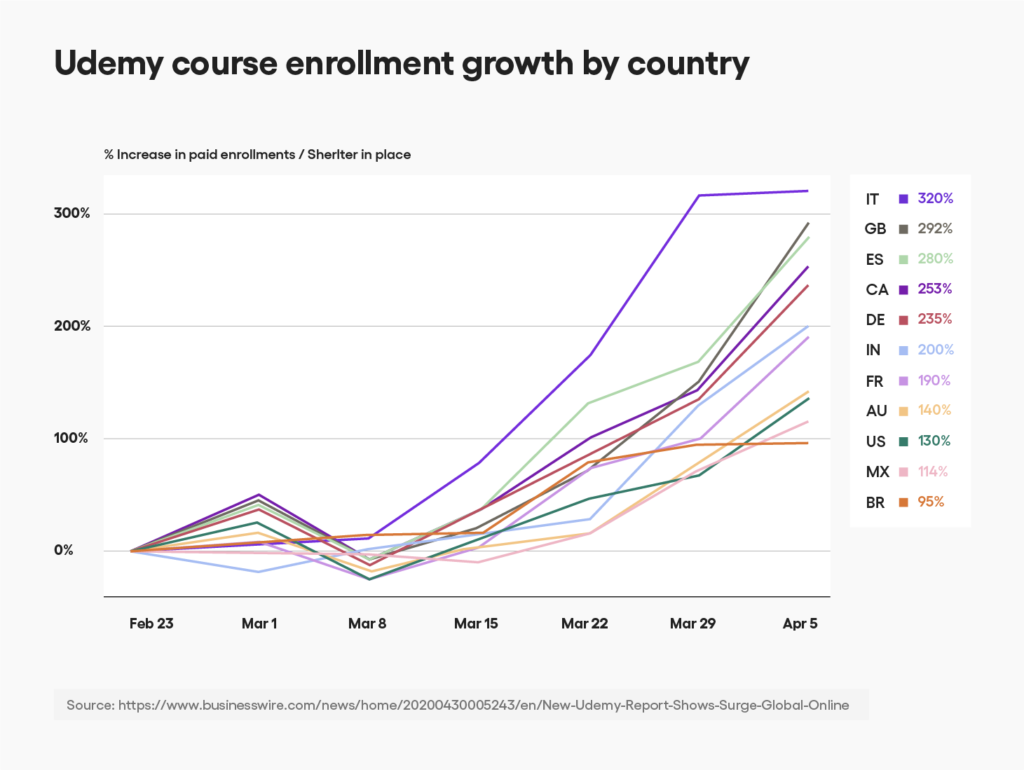
Much like the massive adoption of remote working in the wake of the global pandemic, online or distance learning has seen explosive growth in response to COVID-19, with technology playing an increasingly important role in education. In addition to K-12 and higher education, online courses are flourishing as thousands of bored adults invest their free time in self-improvement.
Although many countries are taking tentative steps back into classrooms and workspaces, the future remains uncertain, spurring prominent universities like Cambridge to announce that classes will continue to be held online until next summer.
In some respects, it’s fortunate that the pandemic hit at a time when we have tools at our disposal to facilitate the continuation of education remotely, although there are still significant disparities in the availability of digital learning technologies and vastly different levels of digital literacy, which can result in uneven learning opportunities. Moreover, for educators and students alike, the switch to distance learning has had a steep learning curve, with instructors and participants often learning on the fly.

In-app live streaming made easy.
The challenges involved in distance learning
There are marked differences between teaching and learning in the physical classroom space and in a remote learning environment, presenting various challenges for educators.
Early correspondence courses always suffered from a lag in communication, and although this has been somewhat remedied by modern technology, effective communication inside and outside of virtual classrooms remains a challenge.
It can be difficult to adapt to a new online environment, which means building trust between educators and students – and among students – is essential. Incorporating voice and video can help establish trust by allowing non-verbal cues like facial expression, body language, and tone of voice to convey intent and put participants at ease.
Remote learning also necessitates a switch in teaching and learning styles, for both students and educators. Teachers need to adapt their lessons to accommodate the strengths and limitations of the medium, which can result in many additional hours of lesson preparation.
Participants also need to manage their time differently, and without the daily habit of physically going to a school or institution – and the social pressure to work created in such an environment – it can be easy to lose motivation, or simply to lose concentration and browse Instagram instead of paying attention.
That’s why one of the major challenges involved in distance learning is creating sustained commitment. Of the thousands of individuals who embark on distance learning programs, only some 13% go the full distance, according to research from Warwick University.
Perhaps the most prominent challenge is the lack of direct human interaction. At the end of the day, we’re social creatures and forming meaningful connections between teachers and students, and among the students or participants themselves, is an important part of the learning process.
In fact, a study undertaken by the researchers from the University of Chicago found that students who participated in specific social learning programs saw an 11% increase in academic performance.
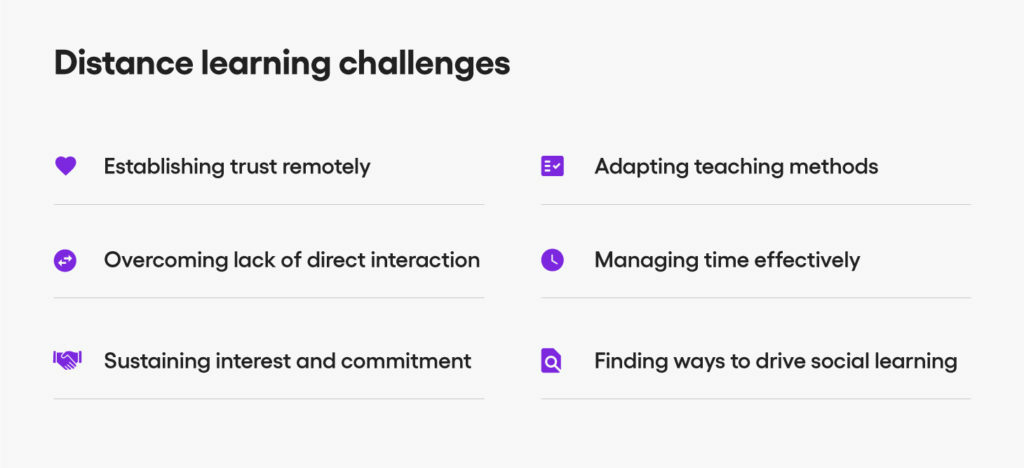
The importance of community in distance learning
Building a sense of community and connection among distance learning participants can play a crucial role in determining the success of the course. Community can be defined as a sense of common purpose and belonging, of being part of something. While establishing a sense of community in the classroom is always important, it’s never been more critical than right now when people are feeling isolated and alone.
A paper by the ASCD notes that “students in schools with a strong sense of community are more likely to be academically motivated; to act ethically and altruistically; to develop social and emotional competencies; and to avoid a number of problem behaviors, including drug use and violence.”
A welcoming member community can make new participants feel more at ease and confident, particularly when that “first day of school” feeling kicks in and a friendly smile and a little conversation is needed to ease nerves and kickstart a sense of belonging. Educators have found this to be crucial in the current circumstances, as students are understandably experiencing stress and loneliness as they adapt to the remote learning necessitated by COVID-19.
Online communities can even help to promote student retention by allowing relationships to form between participants, motivating them to keep returning.
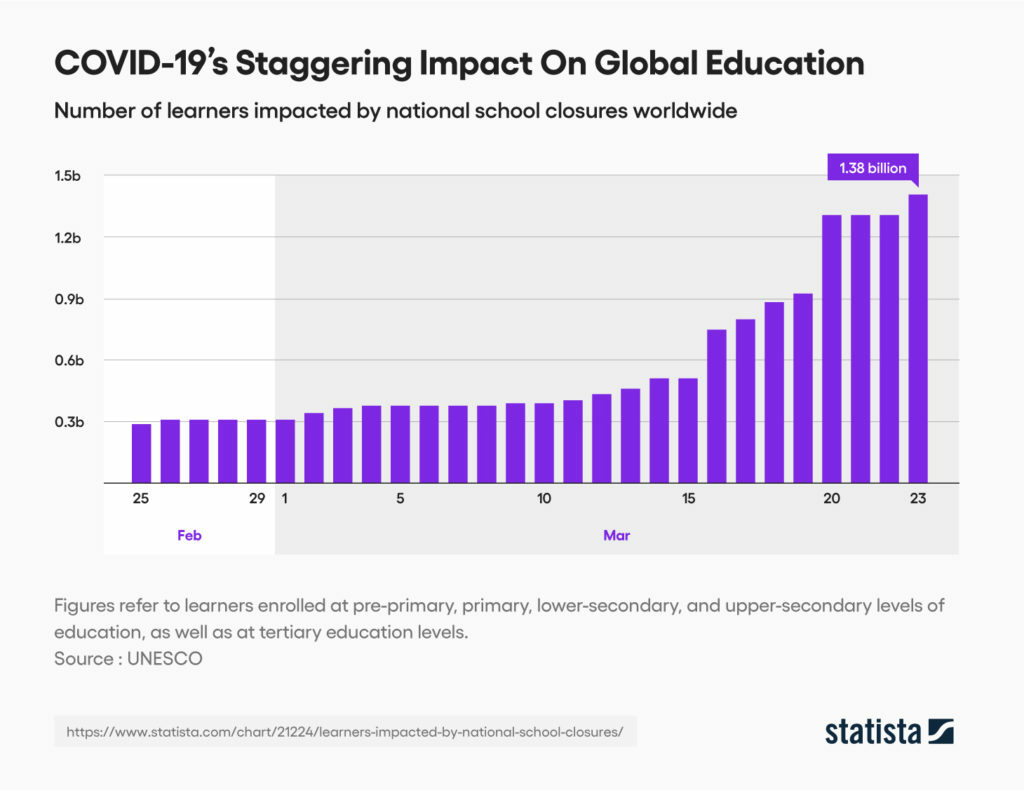
Strategies for cultivating virtual learning communities
By taking full advantage of the technologies available to us today, there are a number of strategies that can be employed to develop healthy distance learning communities that are optimally conducive to learning for adults and children alike – and make educators’ jobs as easy as possible.
Successful online learning communities are reliant on the active participation of their members. For those looking to build one, the crux is providing the right tools to empower students to easily collaborate and learn socially.
Let’s look at some of the ways you can facilitate learning through online community:
Include discussion forums
Facilitating the creation of channels where students can network, either publicly or privately, is a great way to start building up a learning community. A classic example is bulletin-board style forums such as those found on the popular social networking site, Reddit. On Reddit, members can join discussions and post questions and answers on just about any topic. Some of these forums – or ‘subreddits’ as they’re called – are 20 million users strong! Information is publicly available and easy to search, making such forums highly useful learning resources.
For an uninterrupted learning experience, consider building an in-app discussion forum or bulletin board into your learning platform to promote contextual discussion within the learning environment, so that your users don’t need to leave your platform to use Reddit or similar discussion boards.
Use group and one-to-one chat functions
While open forums certainly serve a purpose, they can become bloated and become less relevant to individuals over time. This is where group and one-to-one chat, voice calls, and video chat come into play in supporting more niche or personal topics and queries that students may not want to share with a large number of people.
Enabling students to communicate in real-time through smaller group chats or direct one-to-one messaging has been found to foster stronger interpersonal relationships, resulting in tight-knit communities.
Once again, incorporating these features in-app prevents users from navigating away. If these functions aren’t present in your app, you may find that members leave to start these kinds of interactions elsewhere.
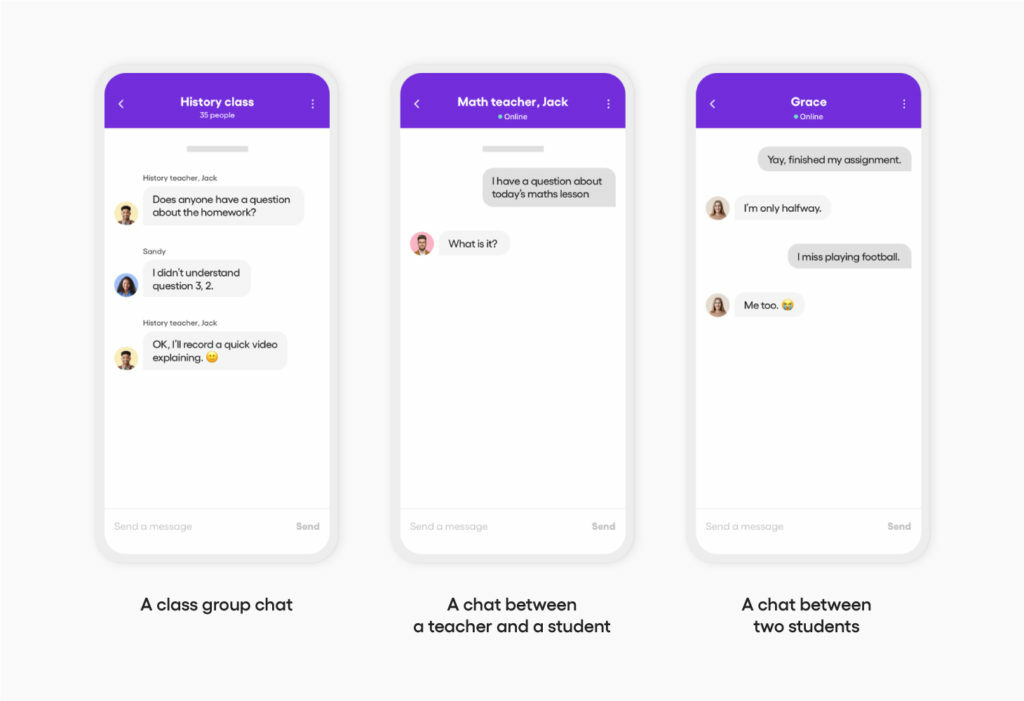
Host interactive video lessons
While perhaps not a true substitute for the real thing, emulating a classroom or lecture hall environment through live video streaming is the best available means of replicating the synchronous classroom-community learning style that most students are accustomed to.
The efficacy of this teaching method is amplified when live streaming is paired with real-time messaging and reactions that continuously engage students. A live chat feature – often used in conjunction with a virtual ‘hands up’ function – allows students to ask questions. Many platforms also include useful features such as live polls to enable teachers to elicit feedback from students or run quick quizzes during lessons.
For instance, an educator may discover after explaining a concept that only 25% of pupils can correctly answer a question related to this concept, immediately alerting them that they need to go over it again.
Video chat also needn’t stop at lessons and can be effectively used to facilitate community-building activities such as virtual breaktimes or morning standups.
Chat and subtitles can also play a vital role in promoting accessibility for all participants.
Facilitate virtual breakout groups
Group assignments are an important means of fostering a sense of classroom community and encouraging students to connect with one another. These can be carried out during class time or as separate coursework. Students or participants can break out into smaller groups to work on assignments at the click of a button, collaborating through the group video chat (and ideally, tools built into the app) and then reconvene again at a predetermined time.
Interestingly, students who wouldn’t normally speak up in real-life situations are more likely to participate in online discussions.
Ensure a safe environment
In order for members to actively engage in a community, they need to feel safe. Inbuilt safety features such as automatic or manual moderation tools, automatic image blocking, profanity filters, and spam flood protection act as a crucial barrier against trolls and toxic behavior, ensuring users feel like they’re part of an open, friendly community.
Prioritizing remote access security, including robust authentication measures and end-to-end encryption, is also important to protect virtual classrooms against unwanted 'guests' and safeguard the personal information of participants – particularly when children are involved.
Leverage gamification
Some of the biggest and most successful online communities are founded on a shared love of gaming, and play is well-established as a fundamental part of learning.
In addition to boosting engagement, a bit of healthy competition can do wonders for motivation.
Popular language learning platform Duolingo, for example, uses a league system based on users’ participation rate (experience gained) as a form of motivation.
If users keep working hard, they move up the leagues and win rewards. Users can also ‘follow’ other users and monitor one another’s activity and have fun competing and chatting in-app. The more followers people gain, the more competition – and motivation – they have.
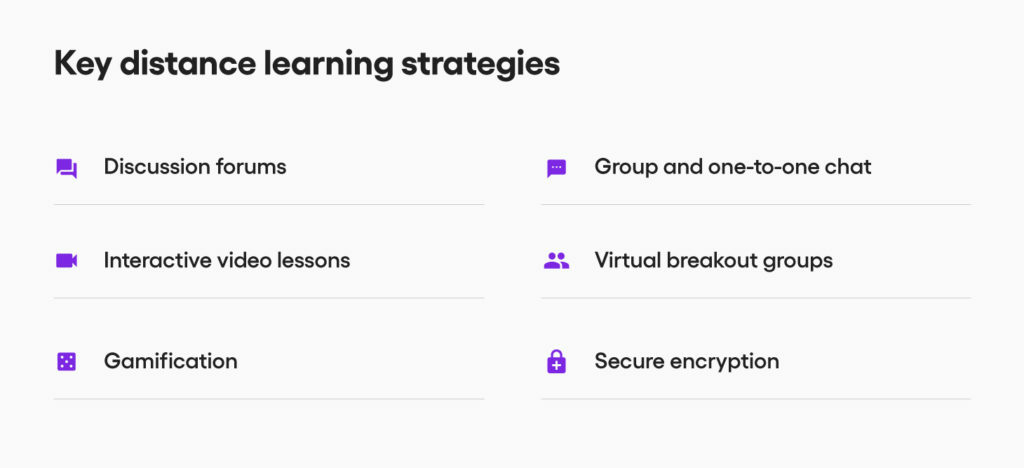
Additional distance learning best practices
Go beyond community
The above strategies are the fundamental building blocks of a thriving online learning community that encourages users to build connection in a remote classroom setting.
However, at some point, students will inevitably have to go it alone and work asynchronously. At this point, a different set of strategies is required to optimize content and maximize learning.
Let’s review some of these distance learning best practices:
Break content into small chunks
While working from home, students will be more susceptible to distraction. Delivering content in small chunks – whether it be text or multimedia format – is an effective method used by educators when designing lessons and course materials because it makes it easier for students to remain attentive.
Harness the power of visuals
The correct use of visuals is a powerful tool in learning, especially online. The majority of people are visual learners and according to studies, well-chosen, relevant visuals help to transmit information faster and make it “stick” in the memory longer.
Build in regular assessments
With less in-person engagement, it’s more difficult for teachers and students to gauge how they’re progressing. Setting regular assessments makes it easier for teachers to track progress, boosts student self-awareness, and can be a nice way to end lessons e.g. with an exit quiz.
Continuously encourage students
Encouragement is crucial in any learning environment, but even more so in distance learning. A mixed approach can be taken, combining automated feedback, marking, direct messaging, and one-to-one conversations.
Consistently celebrating small wins along the way creates a feeling of progress and is the basis for forming desirable habits like turning up for class and completing assignments.
Actively gather feedback
Make it easy for members of your online learning community to share feedback on the efficacy of your content, teaching methods, and the community in general. Methods should be built-in and can take the form of chat widgets, survey forms, or pop-up survey questions.
An added benefit is that, when executed successfully, feedback can make participants feel they are actively contributing to shaping their learning experience, boosting community buy-in.
Include offline features
Some students may have limited internet access, so it’s important to include downloadable content such as lessons, videos, and course materials that can be completed without the need for an internet connection. In-app chat features should be capable of caching messages received while offline, enabling users to access them upon login.
Offer support channels
It’s important that students can access one-on-one support from educators when they need it. Setting virtual “office hours” that can be booked in an online calendar to discuss progress, ask questions, and address learning difficulties is critical, as are the tools that facilitate these conversations – whether it be via a quick check-in text message, a voice call, or video conferencing.
In conclusion
The beauty of distance learning is the increased access to education it offers.
It seems likely that the future of education, much like the future of work, will be a hybrid between co-located and remote learning.
As we’ve seen, distance learning is not without its challenges, but with the right tools, it’s possible to build extremely successful online learning communities that replicate – and, in some ways, surpass – the physical learning experience.
Upgrade your distance learning with Sendbird chat and video
Sendbird’s cutting-edge chat and video platform helps to facilitate world-class distance learning. That’s why educational companies like Chegg, Snappet and Ruangguru already use Sendbird.
Sendbird’s real-time communication solutions help to make your digital education endeavor intuitive and effective by giving educators and learners the tools they need to teach and learn collaboratively.
With our API, it’s easy to include one-to-one and group chat in your distance learning app or platform, optimizing interaction among educators and learners. Sendbird also offers secure voice and video chat capabilities, which is integral to effective distance learning.
Let us take care of your education platform’s communication needs while you focus on what you do best. We understand that time is of the essence and we’ll get you up and running in no time.










